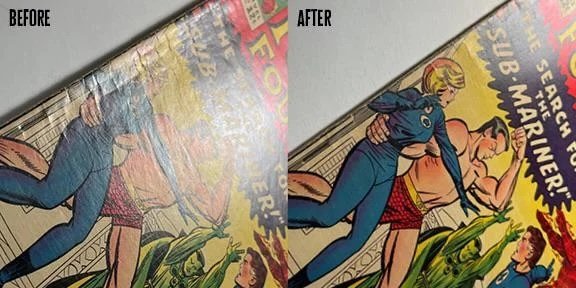How to Spot a Pressed Comic Book: The Collector’s Guide to Knowing What’s Been Smoothed
In today’s comic book market, pressing has become almost as common as grading. But while pressing is a perfectly accepted restoration-free process (at least by CGC standards), being able to spot a pressed book can give collectors an edge — especially when evaluating raw comics or reassessing old slabs.
So, how do you actually spot a pressed comic? Let's dig in — grainy paper, tightened staples, and all.
💡 First: What is Pressing?
Before we start hunting for clues, let’s clarify the crime.
Comic book pressing is a process used to improve a comic’s appearance without adding or removing material. It often removes dents, bends, or light spine roll — like ironing a shirt, but more delicate and with a lot more money at stake.
Unlike restoration (which can add color or replace paper), pressing is not considered restoration by CGC and doesn’t earn that dreaded purple label.
🔍 Tell-Tale Signs of a Pressed Comic Book
Spotting a pressed comic requires a mix of knowledge, close inspection, and sometimes a dash of suspicion. Here’s what to look for:
1. Staples That Look... Off
Staples are like the comic’s fingerprint. After a press, especially one done with a little too much heat or pressure, the staples can shift ever so slightly. Watch for:
Tightened or slightly sunk staples
Misalignment between front and back cover staples
Minor indentations around the staple that look overly crisp or new
If you see a book from 1970 with staple areas that look machine-tight, it may have been pressed.
The comic doctor
2. Paper Texture That’s “Too Flat”
Vintage comics weren’t printed on glossy stock. Their paper was soft, fibrous, and slightly textured.
Pressing can sometimes flatten that texture, leaving a silky-smooth surface that feels unnatural — especially on older books. If you know what unpressed Golden or Bronze Age paper feels like, a slick, almost laminated vibe should raise red flags.
3. Loss of Spine Curl or “Spine Roll”
Older comics (especially newsstand books) often came with a natural spine curl or roll. A pressing job might attempt to “correct” this, and if done right, it looks sharp. But sometimes:
The spine looks unnaturally sharp compared to the rest of the book
There are micro-tears or signs of stress near the spine
You notice color-breaking creases that have flattened, not disappeared
Pressing can’t remove all damage. It just makes it look less offensive.
Pressing-issues
4. Flattened Indentations and “Ghost Lines”
Some clues hide in plain sight:
Old crease marks that are barely visible but still there
Ghost impressions of where a bend used to be
Flattened fingerprints, dents, or stress lines that haven’t disappeared, just softened
This is especially visible under angled light. Tilt the book and scan for unnatural smoothness or shadows of old damage.
S&S comic service
5. Warping Near Edges
Poorly done pressing can sometimes cause slight edge waviness or paper distortion, especially if the humidity or heat levels weren’t balanced during the process.
If a comic looks weirdly “melted” or has slight waves along the borders, especially the top edge, pressing might be the culprit.
🕵️♂️ Slabs and Pressing — Can You Tell?
Here’s the trick: once a comic is slabbed, spotting pressing gets trickier — but not impossible.
Use a flashlight or phone light at an angle. Look for ghost creases or odd surface shine.
Examine slab notes (if available) on GPA or CGC — sometimes the grader notes hint at pressable defects.
Trust your gut: If the book is decades old and looks suspiciously clean, chances are it’s had some spa treatment.
🎭 Why It Matters
Pressing isn’t illegal, unethical, or even uncommon — but it’s not nothing either. Knowing whether a comic’s beauty is natural or enhanced can help:
Determine real market value (pressed vs unpressed can matter, especially with raw books)
Gauge how much room for improvement remains
Decide if a comic is a “good investment” or already at its peak grade
Final Thought
Spotting a pressed comic isn’t about gatekeeping — it’s about being informed. Whether you're a CGC slab loyalist, a raw book aficionado, or a casual reader, being able to read the physical story of a comic makes you a sharper collector.
In the end, pressing may improve the look, but it doesn’t erase the life of a comic. And isn’t that life — the wear, the quirks, the history — what makes collecting fun in the first place?





